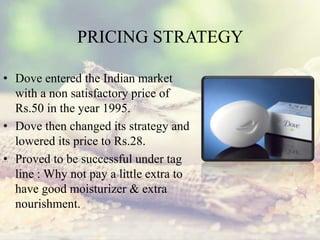dove
- 2. PRESENTED BY…. • NIHAR CHAWDA BBA015151 • ZAIBA KHAN BBA015154 • ADITYA MORDE BBA015155 • TEJ BHEMAT BBA015156
- 3. OVERVIEW OF THE INDUSTRY • India is a country with a population of 1,030 million people with household penetration of soaps is 98%. • Major companies in this industries include divisions of P&G, Unilever and Dial. • Soap is primarily targeted towards women, as they are the chief decision makers in terms of soap purchase. • Major companies in this industries include divisions of P&G, Unilever and Dial.
- 5. OVERVIEW OF THE COMPANY • Unilever is a British-Dutch multinational company founded in 1930. • It’s the world’s third largest consumer goods company. • Unilever owns over 400 brands and is available around 190 countries.
- 7. OVERVIEW OF THE PRODUCT • Dove is a well known brand working under the flagship of Unilever. • It was established in the year 1957 by just launching itself as a cleansing bar. • The products are sold over 80 countries and are available for both men and women.
- 9. OVERVIEW OF THE PRODUCT • Dove cleansing bar is a classic moisturizing formula which focuses on retaining the skin’s moisture. • Promises to leave the skin softer smoother and healthier looking. • It mainly focuses on targeting the female society.
- 10. 4 P’s of Dove…..
- 11. PRODUCT STRATEGY • A combination of moisturizer and softness to satisfy particular needs. • Focused on women with dry skin to give them a naturally smooth experience. • Aimed at maintaining the pH as neutral of the skin.
- 12. PRICING STRATEGY • Dove entered the Indian market with a non satisfactory price of Rs.50 in the year 1995. • Dove then changed its strategy and lowered its price to Rs.28. • Proved to be successful under tag line : Why not pay a little extra to have good moisturizer & extra nourishment.
- 13. PLACE STRATEGY • Dove’s strategy of distribution is no different than its parent – Unilever. • It is distributed through a network of 180 redistribution stockists covering 1 million retail outlets. • It is more popular in metropolitan cities.
- 14. PROMOTION STRATEGY • Positions itself for REAL BEAUTY and is considered good for people of all ages. • It tries to give out a message for all the ladies that beauty is not limited to only certain features.
- 16. Dove segments the market on basis of : • Demographic segmentation – Gender : (females) Income groups : High Income groups and Uppermiddle class. • Psychographic segmentation - It tries to change the perception of women that they can look equally beautiful like other women.
- 17. TARGETING….
- 18. •Targets women of all ages , shapes and sizes. •Especially targets the working women. •Targets higher income group as they can afford a premium soap. •Dove uses market specialization concept.
- 19. POSITIONING…. • Dove is positioned as a personal care brand. • It positions itself not as a soap but as a mildest bathing bar containing 1/4th moisturizer. • Dove differentiates itself by requesting its customers to apply on half the face and see the difference. • Dove is currently at its Growth Stage. • Price quality inferences : Consumers assume goods with high price as an indication of better quality.
- 20. BCG MATRIX OF DOVEMARKETGROWTHRATE CASHCOWSTARS DOGQUESTIONMARK RELATIVE MARKET SHARE
- 22. STRENGHT WEAKNESS • Dove contains 1/4 moisturizing cream. • Zero pH levels. • Flagship product of HUL. •Highly priced for the Indian Market. • Targets only the female segment •Loyal customer base. •High amount of Advertising. •Good quality product. • High price. •No product for teenage males.
- 23. OPPORTUNITIES THREATS • Can target male audience. • Continuous innovation • Increased Competition in this market segment. • Popular only in Metro cities • Can prosper in rural areas. • Can introduce products for males. • Strong competition. • Economic downturn.
- 24. CONCLUSION…. •Dove was able to understand the feelings at the core of their audience. •It proved to be a revolutionary product when compared with its competitors. •It helped in building up the self confidence of various women round the globe to feel beautiful in their own skin.
- 25. BIBLIOGRAPHY • www.hul.co.in • www.dove.co.in • www.strategyonline.com • www.digitalvidya.com • www.google.com


























